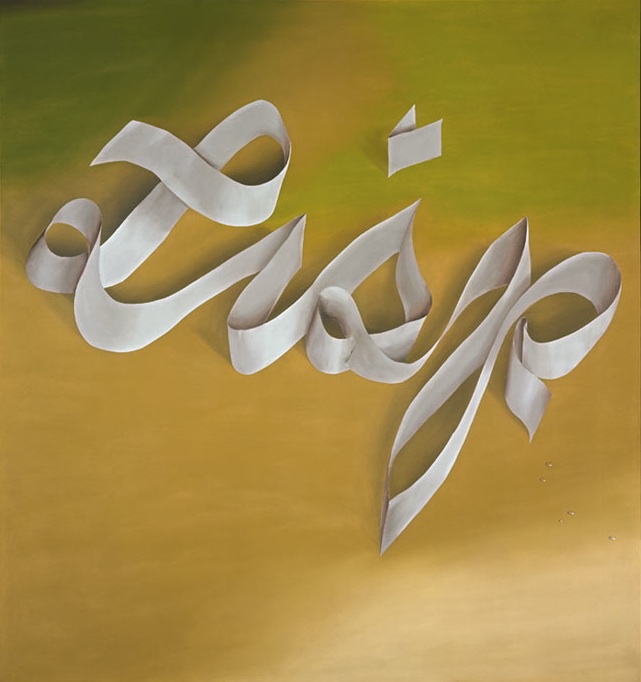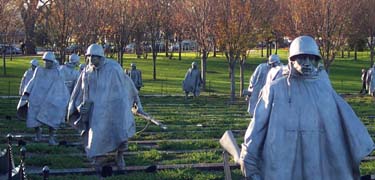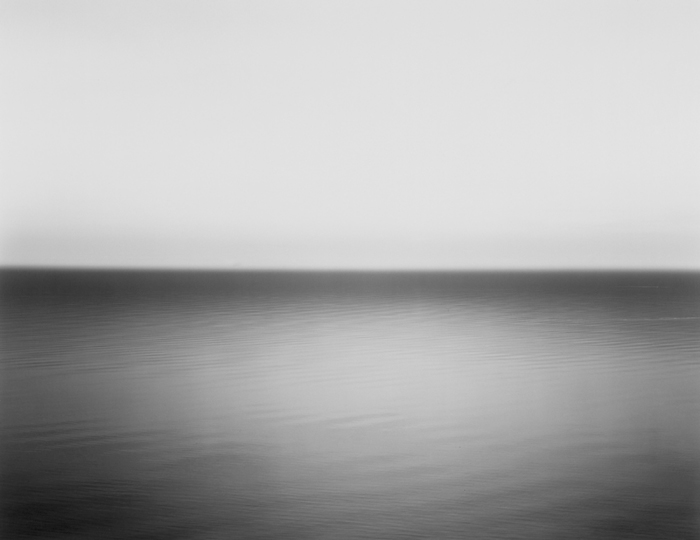
All those things for which
we have no words are lost.
-- Annie Dillard, "Total Eclipse"
 The
Korean War Veterans Memorial
caught me by surprise. No one ever talks about
this memorial, much like the war itself. I had
no idea what it looked liked, no expectations.
When we came upon it from the rear, I became
curious. Standing amid the soldiers trudging
through a field, I was unnerved. They look
over their shoulders, or they make eye contact
with one another, or they stare ahead, blankly.
This is no sterile monument of while limestone.
It is alive, even as it reminds us of men who
no longer are. When we reached the front of
the memorial, we saw a wreath with a note of
thanks from the Korean people. It brought
tears to my eyes, and to my daughter's.
As touched as I was by the National Mall, most
of my memories of the trip are of artwork we
saw in the several galleries and gardens. I
came to remember how much I like the paintings
of Monet. This time, it was his "The Seine at
Giverny" that gave me the most joy. I learned
how much I enjoy the work of Camille Pissarro,
another of the French impressionists who
redefined what a painting could be and say in
the 1800s. I even saw a few abstract pieces by
Josef Albers,
whom I quoted
not long ago.
That quote came back to me as I walked amid the
creations of men, oblivious to computer programming
and the debits and credits of department budgets.
What happens happens mostly without me. Indeed.
The
Korean War Veterans Memorial
caught me by surprise. No one ever talks about
this memorial, much like the war itself. I had
no idea what it looked liked, no expectations.
When we came upon it from the rear, I became
curious. Standing amid the soldiers trudging
through a field, I was unnerved. They look
over their shoulders, or they make eye contact
with one another, or they stare ahead, blankly.
This is no sterile monument of while limestone.
It is alive, even as it reminds us of men who
no longer are. When we reached the front of
the memorial, we saw a wreath with a note of
thanks from the Korean people. It brought
tears to my eyes, and to my daughter's.
As touched as I was by the National Mall, most
of my memories of the trip are of artwork we
saw in the several galleries and gardens. I
came to remember how much I like the paintings
of Monet. This time, it was his "The Seine at
Giverny" that gave me the most joy. I learned
how much I enjoy the work of Camille Pissarro,
another of the French impressionists who
redefined what a painting could be and say in
the 1800s. I even saw a few abstract pieces by
Josef Albers,
whom I quoted
not long ago.
That quote came back to me as I walked amid the
creations of men, oblivious to computer programming
and the debits and credits of department budgets.
What happens happens mostly without me. Indeed.
 I left Washington with a new inspiration,
Hiroshi Sugimoto.
My daughter and I entered one of the gallery rooms
to find a bunch of canvasses filled with blacks,
grays, and whites. "More modern nothingness," I
thought at first. As we absorbed the images,
though, one of us said out loud, "These look like
pictures of the ocean. See here...?" We looked
closer and saw different times of day, different
clouds and fog, horizons crisp and horizons that
were no more than imperceptible points on a
continuum from dark ocean to light sky. Only
upon leaving the room did we learn that these
images were in fact seascapes. "This is modern
art that works for me," said my daughter. I
nodded agreement.
Sugimoto's seascapes are only one element of his
work. I have many more of his images to discover.
I did not get through my eight days away without
any thoughts of computer science. In the
National Gallery of Art, we ran across this
piece by Edward Ruscha,
featured here:
I left Washington with a new inspiration,
Hiroshi Sugimoto.
My daughter and I entered one of the gallery rooms
to find a bunch of canvasses filled with blacks,
grays, and whites. "More modern nothingness," I
thought at first. As we absorbed the images,
though, one of us said out loud, "These look like
pictures of the ocean. See here...?" We looked
closer and saw different times of day, different
clouds and fog, horizons crisp and horizons that
were no more than imperceptible points on a
continuum from dark ocean to light sky. Only
upon leaving the room did we learn that these
images were in fact seascapes. "This is modern
art that works for me," said my daughter. I
nodded agreement.
Sugimoto's seascapes are only one element of his
work. I have many more of his images to discover.
I did not get through my eight days away without
any thoughts of computer science. In the
National Gallery of Art, we ran across this
piece by Edward Ruscha,
featured here:
